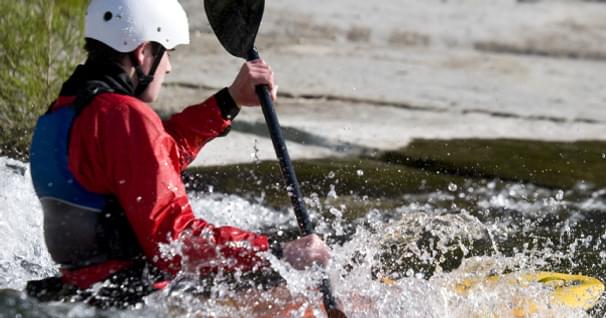Manifest Your Paddling Dreams for This Year Through Emotional Goal Setting
I am taking a different approach to this year's resolutions. Every year I spend a little time over the holidays reflecting on the past year and thinking about what I would like to do differently in the next. I think about how my life could be better; how I could be healthier and happier. This usually involves goals based around eating better, being more active, paddling more, spending more time with my kids/family, etc. Every year I make some resolutions. Nine times out of ten, by the end of January, I feel like I have failed at them and my new year’s resolutions fade away until the following December.

When it comes to setting goals, I have always used some version of the common SMART goal-setting model. Striving to make goals: Specific, Measurable, Achievable, Relevant and Time-bound. This model can work well and has helped many people set and meet their goals, including me. It works well if you are clear on what you want, if your goals are specific and most importantly, if you are able to create and follow a time-line and steps to reach them. However, following the SMART goals model requires a lot of willpower, you have to stick to a regimented plan using your intellectual intelligence to push yourself through each step. When you don’t follow the plan, when your will power wanes (even for a day or two), most people end up feeling like they have failed and end up abandoning the set goal(s).
How to Set Paddling Goals Using Emotional Goal Setting
This year, I have similar goals to other years. I want to paddle more and live a healthier lifestyle. However, rather than approach them linearly with rigid timelines that require daily willpower —which history tells me will fall by the wayside once I am back into busy life after the holidays— I am trying a different approach. This year, rather than intellectual goals that follow my mind, I’m going to try emotional goal setting (urged by my psychotherapist wife), that follow my heart. Here is how I plan to do it.

First I have to visualize what paddling more and being healthier looks like. I will brainstorm images of myself, packing up my gear every Friday in order to paddle every weekend. I will conjure images of myself paddling with my kids, my buddies and with strangers. I will picture myself eating healthy meals, feeling good and looking good with a stronger body, healthy skin and more energy. My visualizations will focus on the end goal, the results (myself paddling more and being healthier), as opposed to the arduous process to get there.
Once I have a good bank of images in my head (I may even describe these images in a journal), each day I will spend two to five minutes visualizing my future self with my goals accomplished. I may do this lying in bed before I get up in the morning, or sit in a comfy spot and look at the sky, or I may do it while I am enjoying a walk on my lunch break. Most importantly, I will connect with and soak up the feel-good emotions of achieving my goals.
By setting my intention and visualizing the results each day I will connect with my goals emotionally as opposed to intellectually. The idea is that my visualizations will make me feel good and accomplished; I will connect emotionally with my future self who has met these goals. My goals will eventually manifest through action. When I live my visualizations (eat a healthy meal, go for a paddle, have an active day) I will soak in the positive emotions that inevitably follow these achievements. When I am faced with a decision, to sleep in on a Saturday or get up early and go paddling, to eat a hamburger or a salad, I am more likely to make the decision that is aligned with my goals in order to feel the familiar positive emotions.
Obviously action is required to reach your goals, you will never run the big drop on your local river, complete a 15-mile crossing in your sea kayak, or spend 10 nights in the wilderness by only sitting around visualizing yourself doing it. However, by visualizing yourself being there and doing it, as opposed to focusing on the many steps it will take to make it happen, you remove the guilt of messing up a step and are more likely to continue trying.
The concept of connecting with our emotions to improve motivation and wellbeing is not new, nor is it witchcraft. Emotional goal setting is a tool being used by many helping professionals, when they find that relying on willpower leaves their clients feeling weak and deflated. The idea is that emotions are a more powerful motivator than willpower. If you can get in touch with emotional energy where you are successfully meeting your goals, you are likely to make daily decisions that align with your goals, without having to think about it.
Whatever your hopes are for yourself in the New Year, perhaps this year, you will try reaching your goals through intention and visualization as opposed to following a linear path dependent on willpower.
Inspired by wanderlust and a passion for rivers, Adrian's paddling addiction has taken him across the globe. After pursuing his degree in Outdoor Recreation and Tourism Management, Adrian eventually settled in Palmer Rapids, Ontario. Here, he has worked for over a decade as the Director Of Operations at The Boundless School.
Related Articles
As the days get shorter and the weather gets colder, it becomes harder to get out and paddle and easier…
If you paddle in cold weather and/or cold water, you may want to invest in a dry suit. Wearing a dry…
Every year we do a family and friends canoe trip. We usually tackle a river in Eastern Ontario or…
Action cameras are everywhere in the outdoors community, and paddling adventures are an obvious match…



